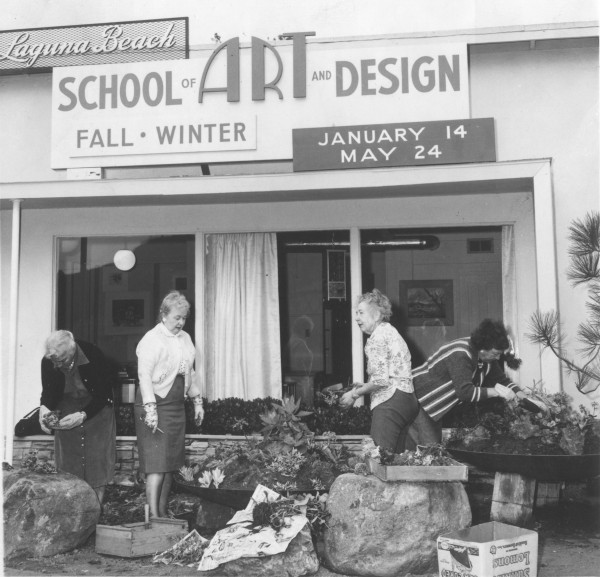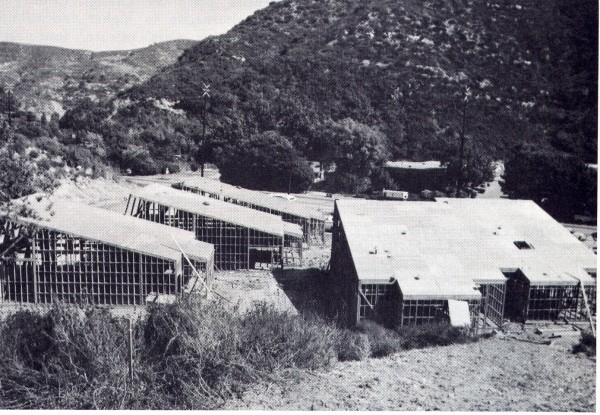By David Randel, Special to the Independent
This account of the school that became the Laguna College of Art & Design, prepared to honor its founding 45 years ago by a group of community leaders, would not be complete without mention of several reasons for its success.
The greatest evidence is the quality of students and their work. This, in turn, is heavily attributable to a cohesive and loyal faculty and staff. The college’s commendable low student to faculty ratio is a major factor.
The beautiful campus in a very desirable community has made its contribution as well. Its emphasis on the traditional fundamentals of a fine art education coupled with modern technology keep the school competitive
The college’s continuing efforts to maintain good relations with the community have also aided its success. Besides offering community art education classes, the school serves the community by hosting varied art exhibits, which are open to the public. Murals and other art produced by its students enrich the community’s public spaces. Joining that legacy will be a new mural at the soon to open Nix Nature Center in the Laguna Coast Wilderness Park.
This account was compiled from many sources. Some are personal recollections from early supporters. Others are excerpts from newspaper clippings and official school documents. As might be expected, some dates conflict.
Sadly, a 1979 fire in the administration building destroyed almost all historical records, so little is recorded of the school’s first 18 years.
Mission Statement
Over the years, the school’s mission statement has changed. The earliest statement upon opening at the Festival grounds in 1962 was “the mission of providing community art education of the highest quality.”
Some sources say the mission reflected a desire to upgrade the art and artists, which exhibited at the Festival. Others suggest the mission aimed at preparing for degree-granting programs.
The current mission statement says:
The Laguna College of Art and Design prepares women and men for careers as creative artists and designers in a culturally and ethnically diverse world and through curricula that emphasize the acquisition of skills based on observation, representation, and concept development. LCAD is committed to offering its curricula through accredited degree programs that imaginatively combine studio work with academic studies, and to sharing its resources with the broader community through continuing education and exhibition programs.

Chronological History
1961
Founded as Laguna Beach School of Art by members of the Festival of Arts and Laguna Beach Art Association (now the Laguna Art Museum) with “the mission of providing community art education of the highest quality in the region.” A former lumber company office between the Festival grounds and the Moulton Theater was leased from the city for $1 a year. The Festival gave $5,000 and 20 friends gave $1,000 each to build the first studios on the Festival grounds.
1962
Founding board established and first classes offered at the new school. Ruth Osgood, (later Osgood Salyer) was the first director who worked without pay to hold the artists together.
1966
Incorporated as a separate legal entity from the Festival but continued to receive its financial support and that of an advisory board of “concerned friends of the school.”
1973
Purchased the first 3.85 acres of the present site from Irvine Co. for $55,000. Athalia Clark, a founding member of Designing Women and mother of Joan Irvine Smith, was instrumental in the purchase.
1976
Construction began. Chris Abel was the first architect and Fred Lang was the landscape architect. The cost of land and buildings was $400,000.

1977
The school moved to its present site and began holding classes.
1978
The mortgage was paid off and a “mortgage burning” event was held in the parking lot. Artist Millard Sheets was the guest speaker. At a gala attended by 370 guests, president David Young announced a goal of $1 million for a permanent endowment fund.
1979
Just six months after the mortgage burning, an electrical fire destroyed the administration building. Twenty eight firemen battled the fire and took 15 minutes to quell the blaze, saving the rest of the campus. The $500,000 loss included records, valuable paintings and most of the library. Classes resumed within a month and trailers served as administrative offices while a new, two-story administrative building was constructed and completed the next year. Fred Biggs was the architect.
1982
Vera Reilly Studio was constructed with funds raised by Designing Women members Pat Hit and Kathie Miller in honor of their mother and dedicated it to housing Color It Orange, the countywide public art event held on campus.
1982
The school received a three-year accreditation from the National Association of Schools of Art and Design and changed the school’s name to Laguna Beach College Of Art.
1983-85
Steps began to prepare for a four-year accreditation and awarding of bachelor of fine arts degrees. Controversy ensued, losing faculty without degrees themselves and dropping community arts courses to make room for BFA classes.
1985
The school becomes Art Institute Of Southern California.
1987
First accreditation as a four-year college granting BFA degrees, the only accredited independent, degree-granting college of art and design in Orange, San Diego or Riverside counties at the time.
1984-1991
A period of self-study and administrative turnover.
1990
Collector’s Choice, an annual major fund raising event, started by Nancy Snyder and Janis Johnson from an idea of friend and artist, Laddie John Dill. Presidents Club started by Gene Parker, who soon fell ill so Nancy Snyder continued the club with John Lottes as the new president.
1990
Our first 15 students graduate with a bachelor’s degree in fine arts. Roger Armstrong , longtime supporter-founder and beloved teacher, is awarded an honorary doctorate.
1993
“Club 66” raises a $66,000 shortfall in $66 increments to buy an additional 1.5 acres from Irvine Co. for $175,000. Nancy Snyder was given a plaque in honor of her efforts on the campaign.
1993
Fire in Laguna Canyon and subsequent mudslides caused to school to close for four days and prompted a dozen students to withdraw. The school escaped unharmed, thanks to firefighters who were honored at a Thanksgiving party.
1996
President John Lottes died from an inoperable brain tumor. During his five year tenure, longer than his eight predecessors, he brought the institution stability, improved its financial position, increased enrollment, developed closer community ties and worked towards WASC accreditation.
1997
First accreditation by WASC.
1997-2004
A period of enrollment growth, addition of computer technology and development of off site studios to accommodate over capacity. President Alan Barkley led creation of a degree in animation and planning of a graduate program.
2002
The name became Laguna College Of Art And Design.
2006
The master’s of fine art program received WASC approval. Off campus site is now called “South Campus.”
Chronology Of Directors/Presidents
Ruth Osgood (later Ruth Osgood Salyer), 1961-1974.
David Patterson, 1974-1976.
Lewis Cohen, interim director, 1976.
Richard Tobin, 1977.
Patricia Caldwell, 1984-1986.
J. Thomas Reeves, 1987.
William Otton, 1988.
Russel E. Lewis, 1990.
John Lottes, 1991.
Oscar Frenzel, interim president, 1996.
Alan Barkley, 1997
Helene Garrison, 2004.
Dennis Power, 2005.
The 1974 board:
John Dundas, Chair, Ruth Osgood Salyer VP-Director, Alexandra Martell Sec’y, M.Paul Stiker Treas, Sue Darrow, Charles Igner, Muriel Reynolds, and David Young.
Designing Women, established November 1974, as a support group with 48 charter members by Muriel Reynolds, its founding president. The were so successful, membership was limited to 100 and a wait list created. Two sponsors were needed for membership.
Their first major effort was fund raising for the construction of the new school in Laguna Canyon. Many subsequent black tie galas were held in prominent private clubs, hotels and special homes with Hollywood celebrities as guests of honor. They often raised $60,000 per event and were a major source of financial support for the school for many years. Designer fashions shows were held as well. Many of the Designing Women leaders and members made countless additional contributions to benefit the school.
Color It Orange. Designing Women founded and sponsored the countywide youth art festival in 1975. This juried show of artwork submitted by students of all grades was exhibited at the Laguna Art Museum for its first five years and subsequently on the school’s campus. An annex was sponsored by Tiffany & Co. at South Coast Plaza for seven years. Nancy Lawrence, a former children’s art teacher at the school, has been its chair since.
Postscript
There are two hidden elements in the school’s history that have contributed mightily to its success.
First, the unique tradition of volunteerism and private support of worthy causes, as cited by Alex de Tocqueville in his classic 1835 work “Democracy in America.”
Secondly, the creative spirit that resides within all human beings has proved a generous provider. Appreciation for creativity has inspired support for the school’s excellent students and faculty.




